|
|
|
|
|
|
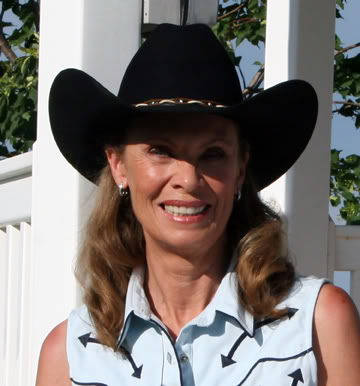 Dear Friends, Dear Friends,
All I can say is “Brrrrr!” I think we are experiencing the coldest and snowiest winter I have seen since I moved to Colorado in 1980! Fortunately, we have a well-constructed facility for the 29 equines and 15 cats that live here at Lucky Three Ranch. Although the barns are not heated, I have found that if they are closed up when it is below zero, they will stay between 30 and 40 degrees just from the breath of the animals.
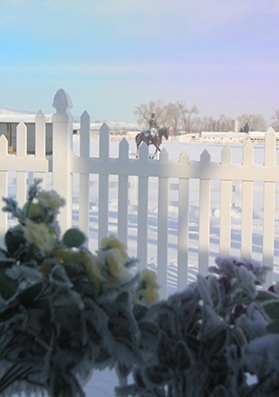 With this much snow and ice on the ground, it is too easy for them to take a misstep and injure themselves if they are allowed outdoors in the turnout pens, so we use the indoor arena instead for a one-hour turnout each day for exercise and general play. This scheduled indoor turnout cuts down on snow and ice-related injuries, so it actually helps save on vet bills. With this much snow and ice on the ground, it is too easy for them to take a misstep and injure themselves if they are allowed outdoors in the turnout pens, so we use the indoor arena instead for a one-hour turnout each day for exercise and general play. This scheduled indoor turnout cuts down on snow and ice-related injuries, so it actually helps save on vet bills.
We have a few animals that are over 25 years old, and five that are over 30 years old. These senior animals do need blankets for additional warmth when it gets really cold, but the use of blankets must always be monitored very carefully. Each animal’s winter hair coat must be exposed to the air and elements often enough to reach its full growth so it can do its job of insulating the animal from the cold when he is not blanketed. The rule of thumb here at Lucky Three Ranch is, if the outside temperature is 20 degrees or below, blankets go on those animals that need them. (Some individuals need a blanket and some fare quite nicely without one.) Mostly, we just watch the animals and they let us know when they really need to be blanketed because they simply start shivering or just stand in a hunched position—both behaviors indicate that they are cold. That’s why constantly watching their behavior when the temperature drops is so important.
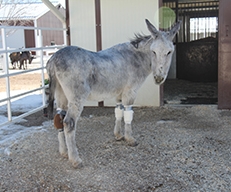 My now 34-year-old Little Jack Horner (L.J.) had a close call shortly after Christmas. Early one morning, my ranch crew woke me and told me that L.J. was cast in his pen with his legs stuck through the panels. Judging by the amount of shavings that had been kicked through the outside door as he had walked in and out before getting stuck, it was determined that he had gotten cast in the pen shortly after the previous evening’s feeding. Because he had been cast for so long, his legs had gone completely numb and it took us six hours to get him on his feet. With me on the lead rope and two men helping him from behind and one more person at his side, we made two rotations around his pen, with L.J. trying to get up and then just crashing to his knees again before the vet got there. When the vet arrived, he gave L.J. some steroids to help his potentially damaged muscles and drew some blood and ran it up to Colorado State University for testing. When the vet returned after several hours, L.J. was back on his feet and standing on his own. After seeing the test results, the vet did find muscle damage, so he gave L.J. a shot of steroids to help the muscles and put him on fluids because he had become dehydrated over night. When he first got on his feet, we quickly placed a couple of sawdust bales under his belly to help him stand, and when the vet came back about two hours later, he was finally standing on his own. After having fluids twice a day for the next three days, L.J. decided to take out the catheter himself! (At this point, we figured he was finally doing fine.) Ever since the accident, I have been wrapping his poor knees and hocks every three days to heal the pressure sores he got from struggling overnight. This picture was taken right afterward, but he is now almost completely healed and in a much better mood! My now 34-year-old Little Jack Horner (L.J.) had a close call shortly after Christmas. Early one morning, my ranch crew woke me and told me that L.J. was cast in his pen with his legs stuck through the panels. Judging by the amount of shavings that had been kicked through the outside door as he had walked in and out before getting stuck, it was determined that he had gotten cast in the pen shortly after the previous evening’s feeding. Because he had been cast for so long, his legs had gone completely numb and it took us six hours to get him on his feet. With me on the lead rope and two men helping him from behind and one more person at his side, we made two rotations around his pen, with L.J. trying to get up and then just crashing to his knees again before the vet got there. When the vet arrived, he gave L.J. some steroids to help his potentially damaged muscles and drew some blood and ran it up to Colorado State University for testing. When the vet returned after several hours, L.J. was back on his feet and standing on his own. After seeing the test results, the vet did find muscle damage, so he gave L.J. a shot of steroids to help the muscles and put him on fluids because he had become dehydrated over night. When he first got on his feet, we quickly placed a couple of sawdust bales under his belly to help him stand, and when the vet came back about two hours later, he was finally standing on his own. After having fluids twice a day for the next three days, L.J. decided to take out the catheter himself! (At this point, we figured he was finally doing fine.) Ever since the accident, I have been wrapping his poor knees and hocks every three days to heal the pressure sores he got from struggling overnight. This picture was taken right afterward, but he is now almost completely healed and in a much better mood!
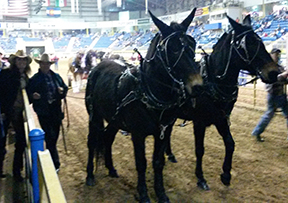 The National Western Stock Show (NWSS) was a fun “field trip” for me and for my ranch crew. Although I no longer show, I go every year because I still like to visit with all of my longears-lovin’ friends who do show there. They are a hearty bunch and should be given credit for the work they do to prepare for the show and travel with their animals at such an inclement time of year. At the NWSS, the mule show is sprinkled in with draft horse classes, so it makes for a really fun show to watch! In this photo, I’m with Fran Howe from the Bitterroot Mule Company and her beautiful team of driving mules. There was a pretty good turnout, all things considered, and the weather got clear and warmer for the mule show weekend like it always seems to do. I think God likes longears too! The National Western Stock Show (NWSS) was a fun “field trip” for me and for my ranch crew. Although I no longer show, I go every year because I still like to visit with all of my longears-lovin’ friends who do show there. They are a hearty bunch and should be given credit for the work they do to prepare for the show and travel with their animals at such an inclement time of year. At the NWSS, the mule show is sprinkled in with draft horse classes, so it makes for a really fun show to watch! In this photo, I’m with Fran Howe from the Bitterroot Mule Company and her beautiful team of driving mules. There was a pretty good turnout, all things considered, and the weather got clear and warmer for the mule show weekend like it always seems to do. I think God likes longears too!
Wishing you all a warm, wet and prosperous spring.
Best wishes and Happy Trails,
|
|
Training Tip:
Question: Meredith, what beginner's training video would you recommend? We’ve corresponded before and I am ready to tackle her training but don’t know where to begin. She is halter broken and leads well. She allows me to brush her and clean her hooves being ground tied. Very sweet.
She is six and trusts me. Comes to me to be loved on...grooms me occasionally. I can touch her and rub her all over. But she shies and backs away from strangers. My goal is for Cricket to allow my grandchildren and adults to approach her and pet her like she does me. We bought her for this reason: therapy mini. Is this realistic?
I don’t know where or how to begin. I’ve watched your YouTube videos and learned quite a bit. Thank you, T.
Answer: It was good of you to take the time to write. You should start with discs #1, #8 and #9 from my DVD series, Training Mules and Donkeys. It isn’t so much about teaching things as it is about building relationships. That is why it is so important to spend adequate time on ground work training. They can learn “things” rather quickly, but it takes time to build a relationship. The information below will clarify what I mean.
No matter how old or how well trained your animal, he needs time to do the simplest of things to get to know you before he will learn to trust and have confidence in you. Just as our children need routine and ongoing learning while they are growing up, so do mules and all other equines. They need clearly outlined boundaries for their behavior in order to minimize anxiety which can lead to inappropriate behavior. The time together during leading training and going forward through lunging and ground driving builds a good, solid relationship with your equine and fosters his confidence and trust in you because you help him to feel good.
Leading training is done for a full year to not only get your animal to learn to lead and so you can develop a good relationship with him, but also to develop good posture and core muscle strength in preparation for the time when you will ride or drive him. Even an older equine with previous training still needs leading training for optimum performance and longevity. During the time you do the leading-training strengthening exercises, you should NOT ride or drive your animal, as this will inhibit the success of the exercises. (If you ride while you do these exercises, it will not result in positive habitual behavior and a new way of going.) The lessons need to be routine and done in good posture to acquire the correct results. You are building new habits in your equine’s way of moving and the only way that that can happen is through a specific routine, consistency in that routine and correctness in the execution of the exercises. Because these exercises require that you are also in good posture, you too will reap the benefits of this regimen. Interacting with Longears is most definitely good therapy if you are willing to do the right kinds of things while you are with them, and once they are fully trained (and you have learned how to manage them), they can be very good therapy for others as well.

|
|
From Our Readers:
I have been reading your articles and have a few of your early books on mules, donkeys and training. I have found your advice and tips rewarding, entertaining and very insightful. Thank you so much. You have done so much for the mule and donkey industry with your education about them and how versatile they actually are.
I’m looking forward to getting more news, articles and advice etc. in your newsletters.
Thanks again so much, M.

|
|
Our Guest Writer: Jan Pollema
Hearts and Horses Summer Camp!
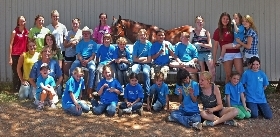
Just around the corner from Lucky Three Ranch, nestled in the foothills of Northern Colorado, lies a very healing place called Hearts and Horses. Hearts and Horses is a therapeutic riding center that offers a depth and breadth of programs designed to empower participants, promote self-sufficiency and encourage growth, both inside and outside the riding arena. We’ve developed a variety of therapeutic and educational programs utilizing our herd of incredible four-legged therapists. One very popular program for children, which has been in existence for 13 years, is the Hearts and Horses Summer Camp.
In 2009, we introduced the All Abilities Horsemanship Camp, partnering children with and without disabilities. Each summer, Hearts and Horses partners with Respite Care for two weeks, creating the experience of a lifetime. The goals of the All Abilities Horsemanship Camp are to promote an inclusive environment that allows campers to celebrate their differences and focus on their similarities, while guiding participants in the development of riding and life skills. Our Summer camp is all about building friendships, expanding horse knowledge and having fun. Every child who attends has at least one thing in common: a love for horses. Respite Care staff says, “It is a life-changing experience that the kids look forward to each summer and talk and sign about all year long!” Spots are filling up fast for the 2014 summer camp, so sign up today at www.heartsandhorses.org
Warm Regards,
Jan Pollema,
Executive Director - Hearts and Horses, Inc.
Sign Up for Hearts & Horses Newsletter

|
|
Bonnie's Bit: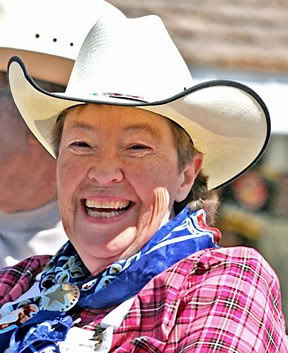
Luckily, my trip down to Las Vegas the first of Dec. for Cowboy Christmas was uneventful and—well, not THAT uneventful. I woke up Tuesday morning to a snowstorm just south of Salt Lake City and the radio said the further south I’d go, the worse it would get. Stupid me gassed up and proceeded south in just awful conditions. I promised myself that if I made it to the next town and things were not getting better, I’d pull off and hole up. The next town was 23 miles. It took forever and it was hairy, even for a “snow driver” like me, but by the time I got through that 23 miles, things were improving so I forged on and pretty soon I was in sunshine and dry roads. BUT, the storm was behind me and coming on steady, so I just kept going. I made it to LV on schedule—to find that only me and Polly Kennedy were on hand to put the whole 50-foot booth up.
We did it as much as we could and finally a few CCI members began to trickle in. It was a miracle. We opened Thursday morning mostly in business, except our treasurer wasn’t coming at all. (The treasurer knows how to run the cash register and do the credit card sales.) Anyway, that is how our show at NFR started and it didn’t get much better. And, the last day, Polly and I were once more all by ourselves all day. I whipped out a sales book and a calculator and a couple of pens and we did the whole day the old-fashioned way—and swore “never again.” Not ever doing NFR and Cowboy Christmas again. Bye-bye to THAT. So, next Christmas, I get to stay home.
Just before I left for NFR, we had a book signing for the little GIGI book I had illustrated and we signed and sold 106 books in three hours. What a kick that was.
2014 has to be better! I am illustrating another little children’s book for a real cowboy over in Montana right now. Nearly have it all done and ready to turn into the publisher/printer. And I have another children’s book waiting in the wings from a fella in CA. Hard to make a living doing this so far, but it keeps me working. And I am hoping to have some time eventually to do some work I have been wanting to do ever since this run of illustrating jobs began last March. Need new material for Bishop, gang.
Winter has been bizarre here this year, with little snow and lots of sub-zero temps. Hay is flying outta the barn, and keeping the water tanks full is a real task, so there are no dull moments these days. Just hanging in there and working hard and waiting on spring. I’ll admit, spring is just a rumor right now, but you know about hope.
Let’s hang in there and keep the faith.
Hugs, Bonnie

|
|
Greetings from the ADMS:

Funny how one always brings weather up in a conversation. If you are talking to someone you don’t know, or to your best buddy in the world, somehow or another, the weather always comes up. Humans and animals are regulated by nature and the weather, even if we think it’s not a deciding factor. The weather controls our food, our travels, even our mail and entertainment. Think about the last time you waited impatiently by the mailbox for your Seed catalog or latest Tack catalog, only to realize it’s quite possible that blizzard between you and the publisher just *might* have caused a delay.
The Internet is wonderful for some forms of communication, therefore mail isn’t as important to us as it once was, but the weather can even affect your Internet. It certainly affects the lives of your animals.
With temperatures, rainfall and snowfall reaching some records here in the last few weeks, we may predict that there will be fewer bugs, winter over sooner, better crops, worse crops. The truth is, it’s hard to predict exactly what will happen. We can try to protect trees that bud too soon when we get a sudden warm spell. We can keep our animals in shelter, clipped or blanketed as need be. But unless there is a real trend of many days off the norm, Mother Nature does tend to take care of her critters.
There are many controversial discussions everywhere (magazines, the Internet) about blanketing equines. Unless the animal is very old, has some health issue, or the weather is truly EXTREME, their coat will grow and protect them if they are in their home climate. Adequate shelter will usually be all they need, but if they are shivering in three feet of (unexpected) white fluffy snow...you might consider changing the game plan.
Above all, keeping on top of their overall care and making sure they are in good health will be your best course. Healthy immune systems, good feed and happy living conditions make for adaptable animals. Not long ago there was a heartbreaking story of a horse dying from a disease that has no cure—but has a common, effective vaccine. Not all vaccines have been around long enough to be proven, but the good old basics have—Eastern/Western/Tet. Not to advocate stabbing your horse or donkey or mule at every opportunity with every vaccine jab out there, but the known-safe preventables—certainly! It’s less of a heart-wrench to give a simple injection than to watch your equine companion shrink away in a matter of days.
We’re in for those funny weather swings for a few weeks longer, so use your mule sense to keep them happy, healthy and warm!
Until next time,
Leah Patton, office manager, ADMS
The Am. Donkey & Mule Soc. PO Box 1210, Lewisville TX 75067 (972) 219-0781. Newsletter: the BRAYER magazine, 100+ pgs 6X/yr, $27 US, $37 Canada, $50 overseas. We now accept Paypal, Visa/MC (+$1 courtesy fee appreciated). Reg info, forms, fees on our website at www.lovelongears.com.
|
|
|
|
|
|
|
|